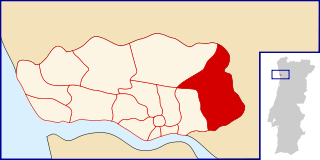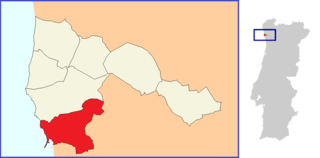
Administratively, Portugal is de jure unitary and decentralized state. Nonetheless, operationally, it is a highly centralized system with administrative divisions organized into three tiers. The State is organized under the principles of subsidiarity, local government autonomy, and democratic decentralization of the public service.

Freguesia, usually translated as "parish" or "civil parish", is the third-level administrative subdivision of Portugal, as defined by the 1976 Constitution. It is also the designation for local government jurisdictions in the former Portuguese overseas territories of Cape Verde and Macau. In the past, was also an administrative division of the other Portuguese overseas territories. The parroquia in the Spanish autonomous communities of Galicia and Asturias is similar to a freguesia.
Salir do Porto is a former civil parish in the municipality of Caldas da Rainha, Portugal. In 2013, the parish merged into the new parish Tornada e Salir do Porto. The civil parish has an area of 9.86 square kilometres (3.81 sq mi) and had a population of 797 at the 2011 census.
Tornada e Salir do Porto is one of twelve civil parishes (freguesias) in the municipality of Caldas da Rainha, Portugal. It was formed in 2013 by the merger of the former parishes Tornada and Salir do Porto. The population in 2011 was 4,358, in an area of 29.53 km².

Trofa is a municipality in the north of the Porto metropolitan area in Portugal, 18 km from central Porto. The population in 2011 was 38,999, in an area of 72.02 km².

Gondomar is a municipality located in the east of Portugal's Porto Metropolitan Area and 7 km from central Porto. The population in 2011 was 168,027, in an area of 131.86 km². Gondomar's mayor is Marco Martins.

Batalha is a town and a municipality in Leiria District, Pinhal Litoral Subregion, Centro Region, Portugal. The town's name means "battle". The municipality population in 2011 was 15,805, in an area of 103.42 km2 (39.93 sq mi). The town proper has around 8,548 inhabitants in an area of 28.42 km2 (10.97 sq mi). The municipality is limited to the North and West by the municipality of Leiria, to the East by Ourém, to the Southeast by Alcanena and to the Southwest by Porto de Mós.

Campanhã is a Portuguese freguesia, located in the city of Porto. The population in 2011 was 32,659, in an area of 8.04 km². Located there is the Campanhã station, the most important in Porto.
Ermesinde is a civil parish in the municipality (concelho) of Valongo, in continental Portugal, 9 kilometres (5.6 mi) northeast of Porto. The population in 2011 was 38940, in an area of 7.65 km². It is the smallest by area, and the densest by population.
Braga is a civil parish in the municipality of Braga, Portugal. It was formed in 2013 by the merger of the former parishes São José de São Lázaro and São João do Souto. The population in 2011 was 14,301, in an area of 2.43 km².

Minde is a town and freguesia of Alcanena Municipality, in the District of Santarém, in Portugal. The population of the entire civil parish in 2011 was 3,293, in an area of 21.14 km². Minde is known as the place of origin of the Minderico, a sociolect or argot spoken by traders. The civil parish is located in a landscape of intensive karst. People who originate from or live in Minde are informally known as Minderico (said to have been created as a variation of Mindense because, as a result of the regional development of the clothing industry, the people of Minde were considered to be wealthy. The formal and ever-used form of Minderico is Mindense.
Oliveira de Azeméis, Santiago de Riba-Ul, Ul, Macinhata da Seixa e Madail is a civil parish in the municipality of Oliveira de Azeméis in Porto Metropolitan Area, Portugal. It was formed in 2013 by the merger of the former parishes Oliveira de Azeméis, Santiago de Riba-Ul, Ul, Macinhata da Seixa and Madail. The population in 2011 was 20,760, in an area of 25.94 km2.

Porto de Mós is a town and a municipality of Estremadura province in Leiria District. It is in the Centro Region and the Pinhal Litoral subregion. The population in 2011 was 24,342, in an area of 261.83 km².

União das Freguesias da Póvoa de Varzim, Beiriz e Argivai is a major part of the Portuguese city of Póvoa de Varzim and the city's south side region. It is one of the seven civil parishes of Póvoa de Varzim. It is, by far, the most populated with 34,266 inhabitants, more than half of the total population in the municipality. The administrative parish evolved from the amalgamation of the former parishes Póvoa de Varzim, Beiriz and Argivai. The population in 2011 was 34,266, in an area of 12.60 km².
Moreira, also known as Moreira da Maia, is a Portuguese town (vila) and civil parish in the municipality of Maia, Greater Porto, Portugal. It was formed in 2013 by the merger of the former parishes Duas Igrejas, Rio Mau, Goães, Godinhaços, Pedregais, Azões and Portela das Cabras. The population in 2011 was 12,890, in an area of 8.67 km².
Perafita, Lavra e Santa Cruz do Bispo is a civil parish in the municipality of Matosinhos, Portugal. It was formed in 2013 by the merger of the former parishes Perafita, Lavra and Santa Cruz do Bispo. The population in 2011 was 29,407, in an area of 22.65 km². It is crossed by the A28. The Porto Airport is situated in its territory.
Aldoar, Foz do Douro e Nevogilde is a civil parish in the municipality of Porto, Portugal. It was formed in 2013 by the merger of the former parishes Aldoar, Foz do Douro and Nevogilde. The population in 2011 was 28,858, in an area of 6.27 km².
Cedofeita, Santo Ildefonso, Sé, Miragaia, São Nicolau e Vitória is a civil parish in the municipality of Porto, Portugal. It was formed in 2013 by the merger of the former parishes Cedofeita, Santo Ildefonso, Sé, Miragaia, São Nicolau and Vitória. The population in 2011 was 40,440, in an area of 5.43 km². It covers the historic part of the city of Porto.
Lordelo do Ouro e Massarelos is a civil parish in the municipality of Porto, Portugal. It was formed in 2013 by the merger of the former parishes Lordelo do Ouro and Massarelos. The population in 2011 was 29,059, in an area of 5.59 km².
Mendiga is a former civil parish in the municipality of Porto de Mós, Portugal. The population in 2011 was 930, in an area of 20.01 km2. It was first mentioned in 1142 but only became a freguesia shortly after 1525. It is home to the multi-sport club ARCD Mendiga. On 28 January 2013 it merged with Arrimal to form Arrimal e Mendiga.











